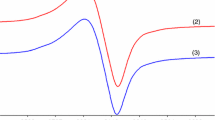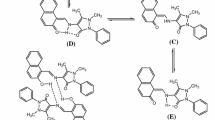Abstract
New complexes of type [Cu(L1)2(OH2)]·4H2O (1), [Cu(L2)(OH2)]·0.5H2O (2) and [Cu3(L3)2(OH2)3]·0.5H2O (3) were synthesized by [1 + 1], [1 + 2] and [1 + 3], respectively, template condensation of 2,4,6-triamino-1,3,5-triazine and salicylic aldehyde in the presence of copper(II). The features of complexes have been established from microanalytical, IR and UV–Vis data. The thermal analyses have evidenced the thermal intervals of stability and also the accompanying thermodynamic effects. Processes as water elimination and oxidative degradation of the organic ligands were observed. After water elimination, complexes revealed a similar thermal behaviour. The final product of decomposition was copper(II) oxide as powder X-ray diffraction indicated.




Similar content being viewed by others
References
Menicagli R, Samaritani S, Signore G, Vaglini F, Dalla Via L. In vitro cytotoxic activities of 2-alkyl-4,6-diheteroalkyl-1,3,5-triazines: new molecules in anticancer research. J Med Chem. 2004;47:4649–52.
Mandal S, Bérubé G, Asselin E, Mohammad I, Richardson VJ, Gupta A, Pramanik SK, Williams AL, Mandal SK. A novel series of potent cytotoxic agents targeting G2/M phase of the cell cycle and demonstrating cell killing by apoptosis in human breast cancer cells. Bioorg Med Chem Lett. 2007;17:4955–60.
Zheng M, Xu C, Ma J, Sun Y, Du F, Liu H, Lin L, Li C, Ding J, Chena K, Jiang H. Synthesis and antitumor evaluation of a novel series of triaminotriazine derivatives. Bioorg Med Chem. 2007;15:1815–27.
Hu Z, Ma T, Chen Z, Ye Z, Zhang G, Lou Y, Yu Y. Solid-phase synthesis and antitumor evaluation of 2,4-diamino-6-aryl-1,3,5-triazines. J Comb Chem. 2009;11:267–73.
Agarwal A, Srivastava K, Puri SK, Chauhan PMS. Syntheses of 2,4,6-trisubstituted triazines as antimalarial agents. Bioorg Med Chem Lett. 2005;15:531–3.
Melato S, Prosperi D, Coghi P, Basilico N, Monti D. A combinatorial approach to 2,4,6-trisubstituted triazines with potent antimalarial activity: combining conventional synthesis and microwave-assistance. Chem Med Chem. 2008;3:873–6.
Klee N, Wong PE, Baragaña B, El Mazouni F, Phillips MA, Michael P, Barret MP, Gilbert IH. Selective delivery of 2-hydroxy APA to Trypanosoma brucei using the melamine motif. Bioorg Med Chem Lett. 2010;20:4364–6.
Baliani A, Bueno GJ, Stewart ML, Yardley V, Brun R, Barrett MP, Gilbert IH. Design and synthesis of a series of melamine-based nitroheterocycles with activity against trypanosomatid parasites. J Med Chem. 2005;48:5570–9.
Dharmendra Patel H, Kishor Chikhalia H, Nisha Shah K, Dhaval Patel P, Pankaj Kaswala B, Vipul Buha M. Synthesis and antimicrobial studies of s-triazine based heterocycles. J Enzym Inhib Med Chem. 2010;25:121–5.
Saleh M, Abbott S, Perron V, Lauzon C, Penney C, Zacharie B. Synthesis and antimicrobial activity of 2-fluorophenyl-4,6-disubstituted [1,3,5]triazines. Bioorg Med Chem Lett. 2010;20:945–9.
Xiong Y-Z, Chen F-E, Balzarini J, De Clercq E, Pannecouque C. Non-nucleoside HIV-1 reverse transcriptase inhibitors. Part 11: structural modulations of diaryltriazines with potent anti-HIV activity. Eur J Med Chem. 2008;43:1230–6.
Baindur N, Chadha N, Brandt BM, Asgari D, Patch RJ, Schalk-HiHi C, Carver TE, Petrounia IP, Baumann CA, Ott H, Manthey C, Springer BA, Player MR. 2-Hydroxy-4,6-diamino-[1,3,5]triazines: a novel class of VEGF-R2 (KDR) tyrosine kinase inhibitors. J Med Chem. 2005;48:1717–20.
Hodous BL, Geuns-Meyer SD, Hughes PE, Albrecht BK, Bellon S, Bready J, Caenepeel S, Cee VJ, Chaffee SC, Coxon A, Emery M, Fretland J, Gallant P, Gu Y, Hoffman D, Johnson RE, Kendall R, Kim JL, Long AM, Morrison M, Olivieri PR, Patel VF, Polverino A, Tempest P, Wang L, Whittington DA, Zhao H. Evolution of a highly selective and potent 2-(pyridin-2-yl)-1,3,5-triazine Tie-2 kinase inhibitor. J Med Chem. 2007;50:611–26.
Huang W, Zheng W, Urban DJ, Inglese J, Sidransky E, Austin CP, Thomas CJ. N4-Phenyl modifications of N2-(2-hydroxyl)ethyl-6(pyrrolidin-1-yl)-1,3,5-triazine-2,4-diamines enhance glucocerebrosidase inhibition by small molecules with potential as chemical chaperones for Gaucher disease. Bioorg Med Chem Lett. 2007;17:5783–9.
Courme C, Gresh N, Vidal M, Lenoir C, Garbay c, Jean-Claude Florent J-C, Bertounesque E. Synthesis of aryl phosphates based on pyrimidine and triazine scaffolds. Eur J Med Chem. 2010;45:244–55.
Wu Y-P, Wang C-J, Wang Y-Y, Liu P, Wu W-P, Shi Q-Z, Peng S-M. Three copper(II) complexes constructed from a new 1,3,5-triazine derivative ligand. Polyhedron. 2006;25:3533–42.
Zhang L, Li W, Zhang J, Li Z-J, Qin Y-Y, Cheng J-K, Yao Y-G. Antiferromagnetic interactions in melamine-bridged trinuclear cobalt complex. Inorg Chem Commun. 2008;11:279–82.
Rubino S, Portanova P, Albanese A, Calvaruso G, Orecchio S, Fontana G, Stocco GC. Mono- and polynuclear complexes of Pt(II) with polypyridyl ligands: synthesis, spectroscopic and structural characterization and cytotoxic activity. J Inorg Biochem. 2007;101:1473–82.
Rubino S, Portanova P, Girasolo A, Calvaruso G, Orecchio S, Stocco GC. Synthetic, structural and biochemical studies of polynuclear platinum(II) complexes with heterocyclic ligands. Eur J Med Chem. 2009;44:1041–8.
Mandal S, Bérubé G, Asselin E, Richardson VJ, Church JG, Bridson J, Pham TNQ, Pramanikd SK, Mandal SK. A new platinum complex of triazine demonstrates G1 arrest with novel biological profile in human breast cancer cell line, MDA-MB-468. Bioorg Med Chem Lett. 2007;17:2139–45.
Chen Z, Wangb X, Li Y, Guo Z. Comparison of DNA binding and cleavage abilities between mono- and trinuclear copper(II) complexes of benzimidazole derivatives. Inorg Chem Commun. 2008;11:1392–6.
Singh K, Singh Barwa M, Tyagi P. Synthesis and characterization of cobalt(II), nickel(II), copper(II) and zinc(II) complexes with Schiff base derived from 4-amino-3-mercapto-6-methyl-5-oxo-1,2,4-triazine. Eur J Med Chem. 2007;42:394–402.
Zhang N, Li M-X, Wanga Z-X, Shao M, Zhu S-R. Synthesis, structures and thermal stabilities of five copper(II) coordination polymers based on 2,4,6-tris(pyridyl)-1,3,5-triazine and 1,2,4,5-benzenetetracarboxylate ligands. Inorg Chim Acta. 2010;363:8–14.
Pouralimardan O, Chamayou A-C, Janiak C, Hosseini-Monfared H. Hydrazone Schiff base-manganese(II) complexes: synthesis, crystal structure and catalytic reactivity. Inorg Chim Acta. 2007;360:1599–608.
Nakamoto K. Infrared and Raman spectra of inorganic and coordination compounds. New York: Wiley; 1986. p. 228–9.
Lever ABP. Inorganic electronic spectroscopy. Amsterdam, London, New York: Elsevier; 1986. p. 565–9.
Dziewulska-Kułaczkowska A, Mazur L, Ferenc W. Thermal, spectroscopic and structural studies of Zn(II) complex with nicotinamide. J Therm Anal Calorim. 2009;96:255–60.
Köse DA, Gökçe G, Gökçeand S, Uzun I. Bis(N,N-diethylnicotinamide) p-chlorobenzoate complexes of Ni(II), Zn(II) and Cd(II) Synthesis and characterization. J Therm Anal Calorim. 2009;95:247–51.
Dziewulska-Kułaczkowska A. Manganese(II), cobalt(II), nickel(II), copper(II) and zinc(II) complexes with 4-oxo-4H-1-benzopyran-3-carboxaldehyde. Thermal, spectroscopic and magnetic characterization. J Therm Anal Calorim. 2010;101:1019–26.
Author information
Authors and Affiliations
Corresponding author
Rights and permissions
About this article
Cite this article
Olar, R., Badea, M., Marinescu, D. et al. Thermal behaviour of new Cu(II) complexes with Schiff bases functionalised with 1,3,5-triazine moieties as potential antibacterial agents. J Therm Anal Calorim 105, 553–557 (2011). https://doi.org/10.1007/s10973-010-1132-y
Published:
Issue Date:
DOI: https://doi.org/10.1007/s10973-010-1132-y




